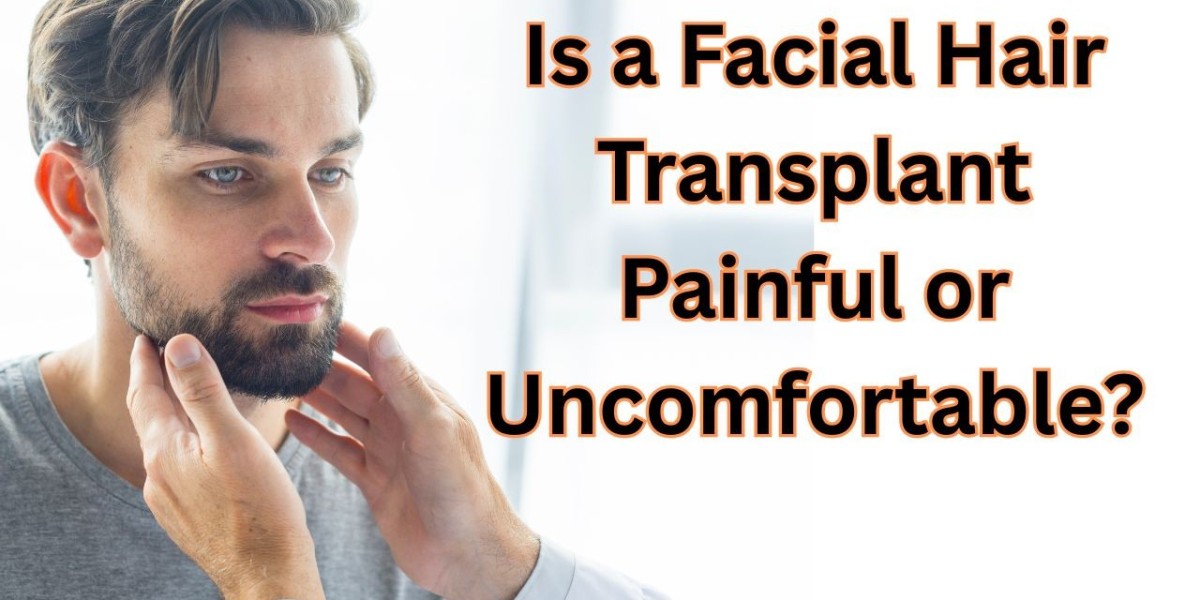A facial hair transplant is a procedure done for cosmetic reasons that restores or enhances hair on the beard, moustache, sideburns, or eyebrows using hair typically taken from the patient's own scalp. More men are opting for this option to achieve fuller, more defined facial hair—whether for aesthetic reasons, to boost confidence, or to fill in patchy areas. One of the most common concerns patients have is: "Will it hurt?" This is a valid question, especially for those new to cosmetic procedures. In this guide, we'll break down everything you need to know about pain management and recovery so that you can make an informed and comfortable decision.
FAQ 1: What Happens During a Facial Hair Transplant?
A facial hair transplant utilises the FUE (Follicular Unit Extraction) technique to restore or enhance areas of the beard, moustache, or sideburns. In this minimally invasive method, healthy hair follicles are carefully extracted from a donor site, typically located on the back of the scalp. These follicles are then strategically implanted into the facial region to match natural hair growth patterns. The procedure normally takes 4 to 8 hours, depending on the area covered. Patients are awake under local anaesthesia, and the results are long-lasting and natural-looking. FUE allows for precise placement, minimal scarring, and a smoother healing process.
FAQ 2: Does the Procedure Itself Hurt?
Are you concerned that a facial hair transplant might cause discomfort? You're not alone—but rest assured, the procedure is surprisingly comfortable. Thanks to the use of local anaesthesia, most patients feel little to no pain during the process. What you will feel is some pressure or movement, but not sharp or intense sensations. Many patients describe the experience as "no pain, just pressure." If you're nervous about needles, don't worry—clinics often use numbing creams and gentle techniques to minimize discomfort. The whole procedure is carefully designed to be smooth and stress-free, allowing you to focus on the exciting results that lie ahead.
FAQ 3: What Can I Expect to Feel After the Procedure?
After the transplant, it's normal to feel mild soreness, swelling, or a sense of tightness in both the donor and recipient areas. These sensations are temporary and typically fade within a few days. You may also notice some itching or small scabs forming—this is a normal part of the healing process and nothing to worry about. Many patients compare the discomfort to a mild sunburn or a light scrape. Following post-care instructions carefully will help ease these symptoms and promote smooth recovery. Overall, the side effects are minor and manageable, making the procedure well-tolerated by most individuals.
FAQ 5: Is the Pain Different for Beard vs. Mustache Transplants?
Yes, the pain can differ between beard and moustache transplants due to varying sensitivity across facial zones. The moustache and chin areas tend to be more sensitive because of denser nerve endings and thinner skin, which can cause slightly more discomfort during and after the procedure. In contrast, the cheeks generally have thicker skin and fewer nerve endings, making the experience more tolerable in that region. However, with local anaesthesia and modern techniques, most patients report minimal pain overall. Understanding these differences helps manage expectations and ensures a smoother recovery from your facial hair transplant journey.
FAQ 6: What Do Most Patients Say About the Pain Level?
Most patients report that the pain level of a beard hair transplant is quite manageable. On a scale of 1 to 10, most rate it between 2 and 4. Many describe it as "less painful than dental work" or "similar to minor skin irritation." Local anaesthesia anaesthesia is used during the procedure, minimising discomfort. One patient shared, "I felt slight pressure, but no real pain." Another said, "The healing was more itchy than painful." Overall, patients find the experience surprisingly tolerable, especially considering the lasting results. The mild discomfort is often outweighed by the confidence boost that comes with new facial hair.
FAQ 8: Can the Recovery Be More Comfortable?
Are you wondering if facial transplant recovery can be more comfortable? Absolutely—with the right preparation and care. Before the procedure, prioritise restful sleep, stay well-hydrated, and refrain from smoking to enhance circulation and promote healing. After your transplant, be sure to follow the post-op guidelines. Gently wash your face, avoid any direct contact with the grafts, and use soft pillows to minimize pressure on the area. Supporting your recovery with a healthy diet, plenty of water, and supplements like vitamin C or zinc can promote faster healing. A calm, well-prepped body responds better—so taking these steps can make your recovery smoother and more comfortable.
Conclusion
In conclusion, a facial hair transplant is a safe and minimally painful procedure that can help you achieve your desired look with confidence. Most patients report only minor discomfort, which is brief and easily manageable with proper aftercare. Modern techniques and skilled hands ensure a smooth process from start to finish. When you choose an experienced clinic, you're not only getting expert care but also peace of mind. Whether you're looking to fill in patchy areas or create a fuller beard, a facial hair transplant offers lasting results with minimal downtime and a natural appearance.
At Beverly Hills Hair Restoration, our expert surgeons utilise advanced, minimally invasive techniques to ensure your comfort throughout the entire process. Schedule a consultation today and take the first step toward the facial hair you've always wanted—without worry.








